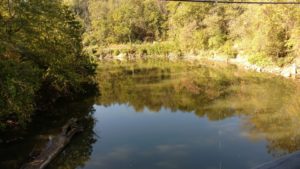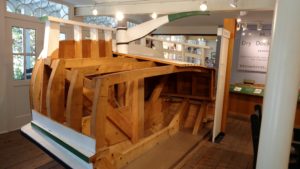Today we stayed camped in one place and made a circle route around the area, returning back to our motel at days end. We are in the heart of Ohio’s Cuyahoga Valley and in the late 1970’s, 33,000 acres of it was made a National Park.
 Our first stop was close to the motel in Independence at the Valley Lock House. This was where there were locks along the canal of the Cuyahoga River that assisted shipping throughout the Midwest. Now it boasts a tow path that is something like 22 miles long and meanders through woods, by falls, marshes and wildlife habitats. Hikers, bikers, and walkers travel it and other trails through the park daily.
Our first stop was close to the motel in Independence at the Valley Lock House. This was where there were locks along the canal of the Cuyahoga River that assisted shipping throughout the Midwest. Now it boasts a tow path that is something like 22 miles long and meanders through woods, by falls, marshes and wildlife habitats. Hikers, bikers, and walkers travel it and other trails through the park daily. 
Unfortunately, the Lock House was closed on Tuesdays. I took a little walk across the river and snapped a few pictures in the morning sun. It was already 88 degrees by 10:00 a.m. (and would reach 94 again for another record September day in the area.) But the river was gorgeous in the morning light.
We got back in the car and headed for an address in Cleveland where my great, great, grandparents lived before they moved to Iowa. John and Carolyn Biggs lived here in 1880 and my second great grandfather was both a “trencher” and a bookkeeper. I assume a trencher was someone who dug trenches. (But, who would know?) Their former neighborhood in the city is now smallish, boxy houses set close to the street on small lots with little to no vegetation around them. Just blocks away it looks like a renewal project was implemented some time in the 1970’s or so. I’m sure there have been lots of changes since their days here. Still, it is so “grounding” to stand on the same soil where my ancestors stood.
From the Biggs’ home on East 37th street, we drove East through neighborhoods that gradually grew into mansions and then gradually shrunk into more or less upper average sized homes today.  The neighborhoods were wooded and manicured and we concluded that Tuesday must be “yard keeper’s day” as many yard services were working along our route. We were on our way in search of the David Berger National Monument located at the Mandel Jewish Community Center. David was one of eleven who were killed during the attack on Israeli athletes during the 1972 Olympic games in Berlin. The monument is simple but completely captivating. The base is made of eleven “legs” holding up the Olympic rings that are all broken. The monument stands as both a reminder of the violence that took place and the hope that one day all violence can be overcome. It’s quite moving. Look closely and you can see visitors have placed stones over each of the “legs” representing each of the athletes, in the Hebrew tradition.
The neighborhoods were wooded and manicured and we concluded that Tuesday must be “yard keeper’s day” as many yard services were working along our route. We were on our way in search of the David Berger National Monument located at the Mandel Jewish Community Center. David was one of eleven who were killed during the attack on Israeli athletes during the 1972 Olympic games in Berlin. The monument is simple but completely captivating. The base is made of eleven “legs” holding up the Olympic rings that are all broken. The monument stands as both a reminder of the violence that took place and the hope that one day all violence can be overcome. It’s quite moving. Look closely and you can see visitors have placed stones over each of the “legs” representing each of the athletes, in the Hebrew tradition.
Back in the car again, we went to find the home of President James Garfield in Menton, OH. It is located on his farm named “Lawnfield” due to all the people who used to come to hear him speak and then stayed to camp on his lawn before making their journey home. The huge house was open for tours and a park ranger introduced us to a volunteer named “Pat” who would be our tour guide. What we learned from Pat is probably not what she would have us remember. We learned the perfect way to avoid giving a tour. My driver and I were the only ones on the tour and at one point when we moved slightly to lean over and look in an adjacent room, she called us back saying, “We’re not looking in there now. That’s where we’re going next.” When we asked a question she responded, “I’ll get to that. You’re throwing me off. I may have to go back to ‘Hi, my name is Pat’ and start all over.” Horrified that that might actually happen, we silently followed her along.
She led us into the large dinning room and admonished us for walking on the carpet. “Stay on the wood. Stay on the floor.” Then she invited us to walk the length of the room looking at a picture on the far wall so we could see how the eyes of the person in the portrait would “follow you” and become younger looking as you approached. “Go ahead,” she encouraged, “You can walk on the carpet now. And if you don’t see it, I’ll make you do it again.” My eyes just about rolled back in my head, but we did as she instructed. I didn’t see a thing. “No reaction?” she exclaimed. I meekly went back to try again with the same result. My driver couldn’t “see” anything unusual, either.
Pat glumly led us into the next room. As we passed a painting in the hall, I exclaimed, “Oh, who is this?” because I knew it must be a saint or an official in the Church. “Oh,” says Pat, “That’s some saint or other.”
“I can see that, I responded. Which saint?”
Pat shook her head slightly, trying not to show her distaste, “Oh, I don’t know. It doesn’t matter to me!”
Unfortunately, I couldn’t help myself and blurted out, “Well, it matters to me.”
From that point on, Pat was less than informative (if she had been that earlier) and was eager to get us to the exit. We learned very little about Garfield and his life in this house, but we did learn about the wall paper; the additions; and the bank vault where his wife kept all his papers and sat and read them after his death.
I’m not sorry I went on the tour, because I did learn how NOT to give a tour, should I ever be in that position again! I learned to be ever more vigilant when trying to teach someone something. First, try to get to know my student; second, listen and answer any questions with the best of my ability, or admit humbly that I don’t know; and third, not to be a volunteer tour guide if I don’t want to engage with inquisitive people. There is grace in this learning. And, in addition, I did enjoy the beauty of this big, old house.
 In the museum dedicated to Garfield’s very short presidency there was a very interesting fact. “Fake news” existed even in the 1880’s. Someone had written a letter about Garfield that was not true and news of it traveled so widely it was difficult for him to refute. It did the damage intended, but he still won the election.
In the museum dedicated to Garfield’s very short presidency there was a very interesting fact. “Fake news” existed even in the 1880’s. Someone had written a letter about Garfield that was not true and news of it traveled so widely it was difficult for him to refute. It did the damage intended, but he still won the election.
 The front porch of the house at Lawnfield is famous because Garfield did most of his campaigning from that front porch. He was the first candidate to have the people come to him instead of him going out to meet the people. I found this quite interesting.
The front porch of the house at Lawnfield is famous because Garfield did most of his campaigning from that front porch. He was the first candidate to have the people come to him instead of him going out to meet the people. I found this quite interesting.
 From Menton, we traveled back into the Cuyahoga Valley and stopped at the Boston Store Visitor Center of the Park where we learned about how the canal boats were made, watched the instructional film and toured the grounds of what was once a small town in the center of the valley. It was quite beautiful on this very sunny, although hot, September day.
From Menton, we traveled back into the Cuyahoga Valley and stopped at the Boston Store Visitor Center of the Park where we learned about how the canal boats were made, watched the instructional film and toured the grounds of what was once a small town in the center of the valley. It was quite beautiful on this very sunny, although hot, September day.
We left the park famished and went in search of food. I had seen a Texas Roadhouse earlier in the day when we were closer to Cleveland and had exclaimed, “I LOVE Texas Roadhouse! They have them here.” So, my darling driver found the closest Texas Roadhouse and we enjoyed a lovely and filling evening meal.
I took my requiste walk around the parking lot tonight, but the sky was not near as stunning as last night. Each day is so different; each experience a memory to be relished; and each moment one of grace.